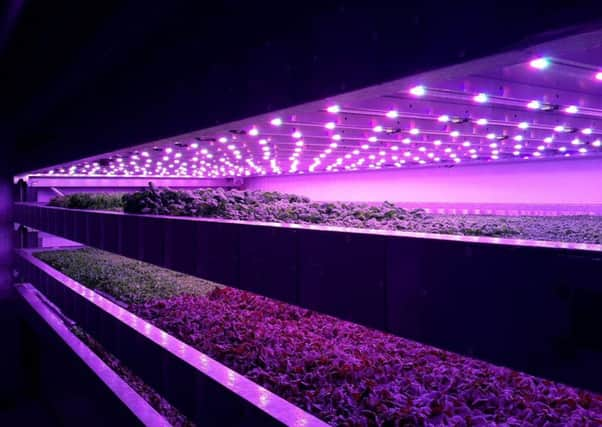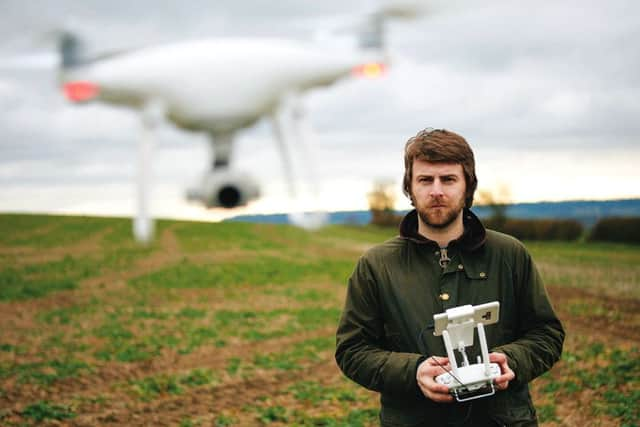How Scottish farmers are diversifying to tackle food poverty


Globally, some 113 million people across 53 countries reportedly experienced food poverty last year, and it is expected that the world’s population will reach 9.8 billion by 2050, according to the UN.
However, inventive organisations across Scotland are devising new and creative ways to tackle the global food shortage.
Invergowrie-based Intelligent Growth Solutions (IGS) has created Scotland’s first vertical farm, pictured here, and the company has recently harvested a £5.4 million cash boost from the Scottish Investment Bank, agri-food investor S2G and online venture capital firm AgFunder.


The firm, which is based at the James Hutton Institute situated on the outskirts of Dundee, provides vertical farming technology to enable efficient food production through indoor crops around the world, having built its demonstration facility at Invergowrie last year.
It features stacked layers, LED lights and app-controlled air vents to create the perfect conditions for crops to thrive all year round.
The early-stage company states that its patented Internet of Things-enabled power and communications platform is able to reduce an organisation’s energy usage by up to 50 per cent and labour costs by up to 80 per cent, in comparison to other indoor growing environments, and can produce yields of 225 per cent compared to crops that have been grown under glass.
IGS experimented with coloured LED lights, growing basil plants at the indoor facility in an impressive 20 days.
Its chief executive, David Farquhar, explains that such developments are urgently needed because at present an astonishing 30 per cent of the world’s food is put to waste.
“Vertical farming allows experimentation to take place in order to impact the yield or cost of production, flavour, nutrients, appearance or a combination of those things,” he says.
“Producers want consistency, assurance of supply, and to know they are going to fill supermarket shelves or supply those Michelin-starred restaurants every day of the week. Those are things that farmers struggle with all the time.”
Farquhar adds: “If there is a forecast for bad weather and a supermarket decides to only take half of their delivery, what are they going to do with the rest of the produce?”
Using the vertical farm, a crop’s growth can be slowed down or sped up to prevent waste.
“People have been talking about vertical farms for several years, but we are now at the starting point. Over the next six months, we will get going with the first technology in the world that is capable of delivering this on an industrial scale.”
The firm, which was formed in 2013, plans to use this recent funding to create jobs in areas such as software development, engineering, robotics and automation.
Investment into such areas is also needed across Scotland because dietary demand is changing, according to David Ross, chief executive of Edinburgh-based Agri-EPI Centre.
“Environmental sustainability is personal now for everyone and therefore there are challenges for primary producers to adapt to the needs of the consumer, the needs of society and the overall sustainability of the planet,” he says.
The Agri-EPI Centre – short for the Agricultural Engineering Precision Innovation Centre – sits across all areas of the sector and works with partners to deliver solutions to make processes more economically sustainable. It is one of four agritech centres established by the UK government to create a collaboration between academia and the innovative agri-food sector.
By 2025, staff at the centre expect the autonomous farm equipment market to be worth more than £129 billion globally and the precision farming market to stand at £7bn.
Ross maintains: “Precision technology is a key unlocker of the environmental challenges the industry faces, and very simply – things like self-steer tractors, for example, which are being used increasingly on farms – make operations more efficient. Farmers can apply fertiliser or plant seeds via a computer which ensures the overlap is optimal and the field margins are in place so as not to over-fertilise.”
The centre recently announced it is managing a three-year hands-free farm project at Harper Adams University in Shropshire, which aims to be the world’s first to grow, tend and harvest a crop without people on the ground or in the driving seat. It will include three crops across 35 hectares and is a vision of future farming across the UK.
“We are addressing the autonomous market and supplying those services to the UK by incubating companies looking to develop solutions in partnership with institutes that have the expertise, such as Harper Adams University and Strathclyde University,” adds Ross.
“Strathclyde University has a big footprint in this area, with interesting robotic solutions as well, so we see this as being one of the key elements for the UK’s agriculture industry in the very near future.
“There will be ups and downs on this as we go forward, but as we see more adoption of such technology, there will be more data available and so more opportunities to do something extraordinary with it.”
The view from above
To ensure farming resources are being used as efficiently as possible, many farmers are turning to digital innovations to turn a profit.
Alnwick-based Drone AG has launched an automated crop-monitoring smart phone application using drones, providing farmers across the UK with real-time information to efficiently target pesticides.
The Skippy Scout system involves drones autonomously flying around a field to collect high-resolution images, which are analysed by the AI-based software.
Co-founder Jack Wrangham explains: “We recognised ease of use as a barrier to precision farming for a lot of farmers, so we started thinking about where we can actually use drones as a time-saving tool before anything else. What Skippy Scout is all about is providing a really useful time-saving tool.”
Wrangham hopes to develop his technology for large-scale pesticide spraying in the future, but current legislation in the UK prevents the use of drones for this.
“Loads of other countries are already doing it and I do think we should get moving as fast as possible as the benefits are huge to any farmer,” he insists.
Many others in the sector are also turning to satellite technology to improve their business performance.
Precision agriculture firm Rhiza has announced that it is offering an affordable precision soil-mapping service utilising satellite data developed through a collaborative two-year research project with the Agri-EPI Centre, Ag-Space Agriculture, Cranfield University and the James Hutton Institute.
The technology aims to help more farmers and landowners enter the precision farming market, and Rhiza claims it would cost farmers 50 per cent less than traditional soil mapping. The service is now employed on more than 800,000 arable hectares in the UK.
Meanwhile, the Agri-EPI Centre has a network of 28 UK satellite farms set up as test-beds for research to improve the productivity and efficiency within the sector.
It measure the variances within each system using precision agriculture equipment and sensors, with the data stored centrally in the cloud.
Innovation planted front and centre
At the Soil Association, innovation does not simply mean new technologies, rather a new way of doing things, according to David Michie, head of Farming and Land Use at the organisation.
Through the Rural Innovation Support Service, which launched last year, the association links farmers to expert facilitators from partner organisations to develop a viable project and explore innovative ideas.
“We are trying to innovate across the supply chain,” Michie explains. “A farmer might have an innovative idea and we will provide the facilitator who will work with them and look at the idea in a wider context.
“They can bring in anyone suited to the project such as researchers or potential buyers and the approach is bottom-up, with farmers coming up with the ideas and us supporting them with a plan to test them.
“There is the common theme of finding a problem, and our service just supports people in doing whatever it is they want to do by developing innovative ways to provide solutions.”
More information can be found at www.innovativefarmers.org/welcometoriss
This article first appeared in The Scotsman’s autumn edition of Vision. A digital version can be found here.